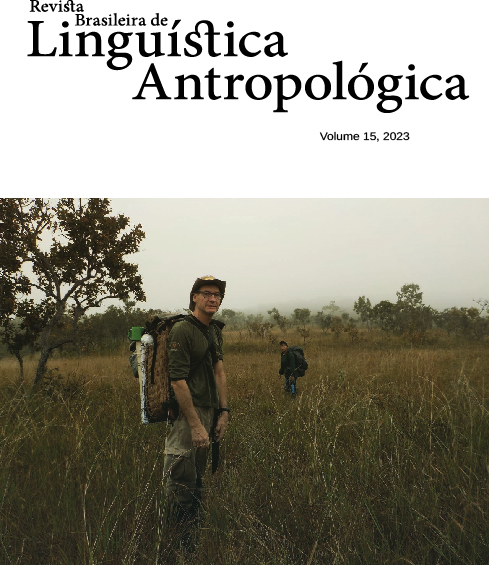Silence, nasality and laryngeality in Brazilian indigenous languages.
DOI:
https://doi.org/10.26512/rbla.v15i1.51466Keywords:
Silence, nasality, laryngealityDownloads
References
Abercombre, D. 1998. Elements of general phonetics. Edimburgo: University Press, 1967.
Aikhenvald, A. Y. Bare. 1995. Munique: LINCOM.
Anderson, S. R. 1974. The organization of phonology. Nova York: Academic Press.
Battisti, C. 1938. Fonetica generale. Milão: Hoepli.
Brosnahan, L. F.; Malmberg, B. 1970. Introduction to phonetics. Cambridge: Heffer.
Catford, J. C. 1977. Fundamental problems in phonetics. Bloomington: Indiana University Press.
Cavalcante, M. P. 1987. Fonologia e morfologia da língua Kaingáng: o dialeto de São Paulo comparado com o do Paraná. Tese de doutorado, UNICAMP. Campinas,.
Cavalcante, M. P.; Rodrigues, A. D. 1982. Assimilação intrassegmental em Kaingáng. Ciência e Cultura, p.34-37.
Chomsky, N.; Halle, M. 1868. The sound pattern of English. New York: Harper & Row1.
D’Angelis, W. da R. 1998. Traços de modo e modo de traçar geometrias línguas Macro-Jê e teoria fonológica. Tese de doutorado, UNICAMP. Campinas.
Davis, I. Comparative Jê phonology. 1966. Estudos Lingüísticos: Revista Brasileira de Lingüística Teórica e Aplicada 1.2, p. 10-14.
Dieth, E. Vademekum der Phonetik. 1840. Berna: A. Francke.
Essen, O. von. 1957. Allgemeine und augewandte Phonetik. Berlim: Akademie-Verlag.
Everett, D. L. 1980. Aspectos da fonologia Pirahã. Dissertação de mestrado, UNICAMP. Campinas.
Franceschini, D. 1999. La langue Sateré-Mawé: description et Analyse morphosyntaxique. Tese de doutorado, Universidade de Paris VII. Paris.
Gili Gaya, S. 1950. Elementos de fonética general. Madri: Gredos.
Gudschinsky, S. C. et al. 1970. Native reaction and phonetic similarity in Maxakali phonology. Language 46, p. 77-88.
Heinrichs, A. H. 1864. Os fonemas do Mura-Pirahã. Boletim do Museu Paraense Emílio Goeldi, Belém, n.s., (Antropologia, 21)
Heffnerm, R. M. S. 1950. General phonetics. Madison: University of Wisconsin Press.
Hockett, C. 1955. A manual of phonology. Memoir, 11, Baltimore, Indiana University, Publications in Anthropology and Linguistics, Waverly Press.
Hyman, 1975. L. M. Phonology: theory and analysis. New York: Holt, Rinehart, and Winston.
Jakobson, R. et al. 1952. Preliminaries to speech analysis. Cambridge, Mass.: MIT Press.
Jakobson, R; Waugh, L. R. 1979. The sound shape of language. Bloomington: Indiana University Press.
Kaiser, L. 1957. (Org.). Manual of phonetics. Amsterdam: North-Holland.
Ladefoged, P. Preliminaries to linguistic phonetics. 1971. Chicago: University of Chicago Press.
Leite, Y. F.; Soares, M. F. 1991. Vowel shift in the tupi-guarani language family. In: Key, M. R. (Org.). Language change in south american indian languages. Philadelphia: University of Pennsylvania Press.
Lindskoog, J. N.; Brend, R. M. 1962. Cayapa phonemics. In: Elson, B. (Org.). Studies in ecuadorian indian languages. Norman: SIL, v. 1, p. 31-44.
Malmberg, B. (Org.).1970. Manual of phonetics. Amsterdam: North-Holland.
Matisoff, J. A. 1975. Rhinoglottophilia: the mysterious connection between nsality and glottality. In: Ferguson, C. et al. (Orgs.). Nasálfest. p. 265-287.
Meader, R. E. 1967. Iranxe: notas gramaticais e lista vocabular. Rio de Janeiro: Museu Nacional.
Meer, T. H. van der. 1981. A nasalização em limite de palavra no Suruí. Estudos Lingüísticos, Anais de Seminários do GEL, v. 4, p. 282-287.
Meer, T. H. van der. 1982. Fonologia da língua Suruí. Dissertação de mestrado, UNICAMP. Campinas.
O’Connor, J. D. 1973. Phonetics. Middlesex: Penguim.
Pike, K. L. Phonetics. 1943. Ann Arbor: University of Michigan Press.
Popovich, H. 1945. The sun and the moon, a maxacali text. In: Estudos sobre línguas e culturas indígenas. Brasília: SIL.
Rodrigues, A. D. 1978. A língua dos índios Xetá como dialeto guarani. Cadernos de Estudos Lingüísticos, UNICAMP, 1, p. 7-11.
Rodrigues, A. D.. 1981. Nasalização e fronteira de palavra em Maxakali. Anais do V Encontro Nacional de Lingüística, Rio de Janeiro: Pontifícia Universidade Católica, v. 2, p. 305-311.
Rodrigues, A. D.. 1984. Contribuições das línguas indígenas brasileiras para a fonética e a fonologia. In: Solá, D. F. (Org.). Language in the Americas. Ithaca: Cornell University, p. 263-267.
Rodrigues, A. D. 1996. Silêncio, pausa e nasalização. Anais do 8º Encontro Nacional de Lingüística, Rio de Janeiro: Pontifícia Universidade Católica, p. 153-158.
Rodrigues, A. D.; Alves, P. M. 1992. Sobre laringalização e nasalidade em Tupari. Comunicação ao IV Encontro Nacional de Fonética, Niterói.
Sandalo, M. F. 1989. Aspectos da língua Pirahã e a noção de polifonia. Dissertação de mestrado, UNICAMP. Campinas.
Trubetzkoy, N. S. 1939. Grundzüge der Phonologie. Travaux du Cercle Linguistique de Prague 7. Praga.
Wetzels, L. 1995. Contornos nasais e estrutura silábica em Kaingang. In: ―. (Org.). Estudos fonológicos das línguas indígenas brasileiras, Rio de Janeiro: UFRJ, p. 265-296.
Wiesemann, U. 1972. Die phonologische und grammatishe Struktur der Kaingáng-Sprache. Haia/Paris: Mouton.
Downloads
Published
How to Cite
Issue
Section
License
Copyright (c) 2023 Revista Brasileira de Linguística Antropológica

This work is licensed under a Creative Commons Attribution 4.0 International License.
Authors who publish in RBLA agree to the following terms:
a) Authors maintain the copyright and grant the journal the right of first publication, and the work is simultaneously licensed under the Creative Commons Attribution License, which allows the sharing of the work with recognition of the authorship of the work and initial publication in this journal.
b) Authors are authorized to assume additional contracts separately, for non-exclusive distribution of the version of the work published in this journal (eg, publish in an institutional repository or as a book chapter), with recognition of authorship and initial publication in this journal.
c) Authors are allowed and encouraged to publish their work online (eg, in institutional repositories or on their personal page) at any point before or during the editorial process, as this can generate productive changes, as well as increase impact and citation of the published work.







